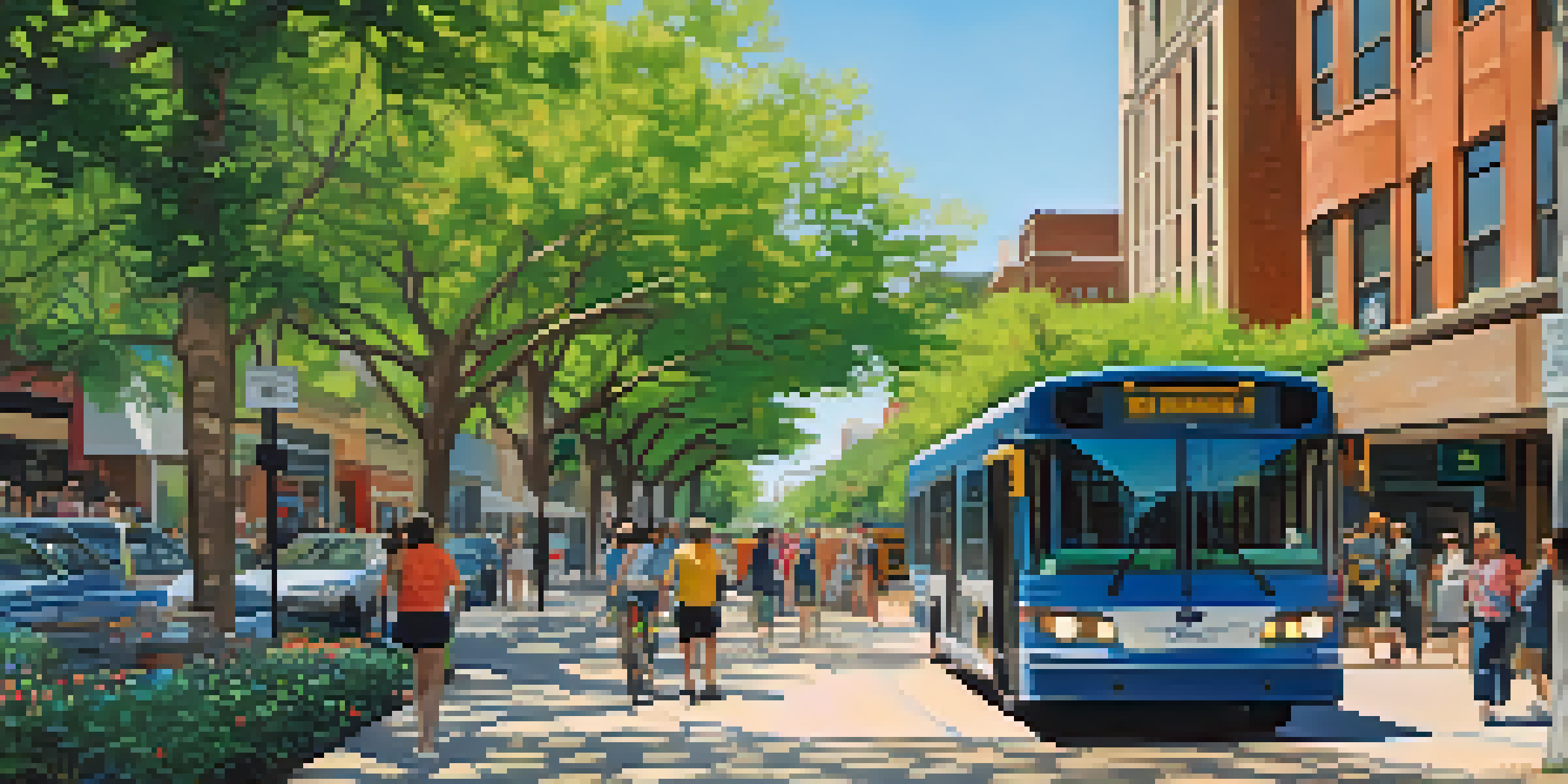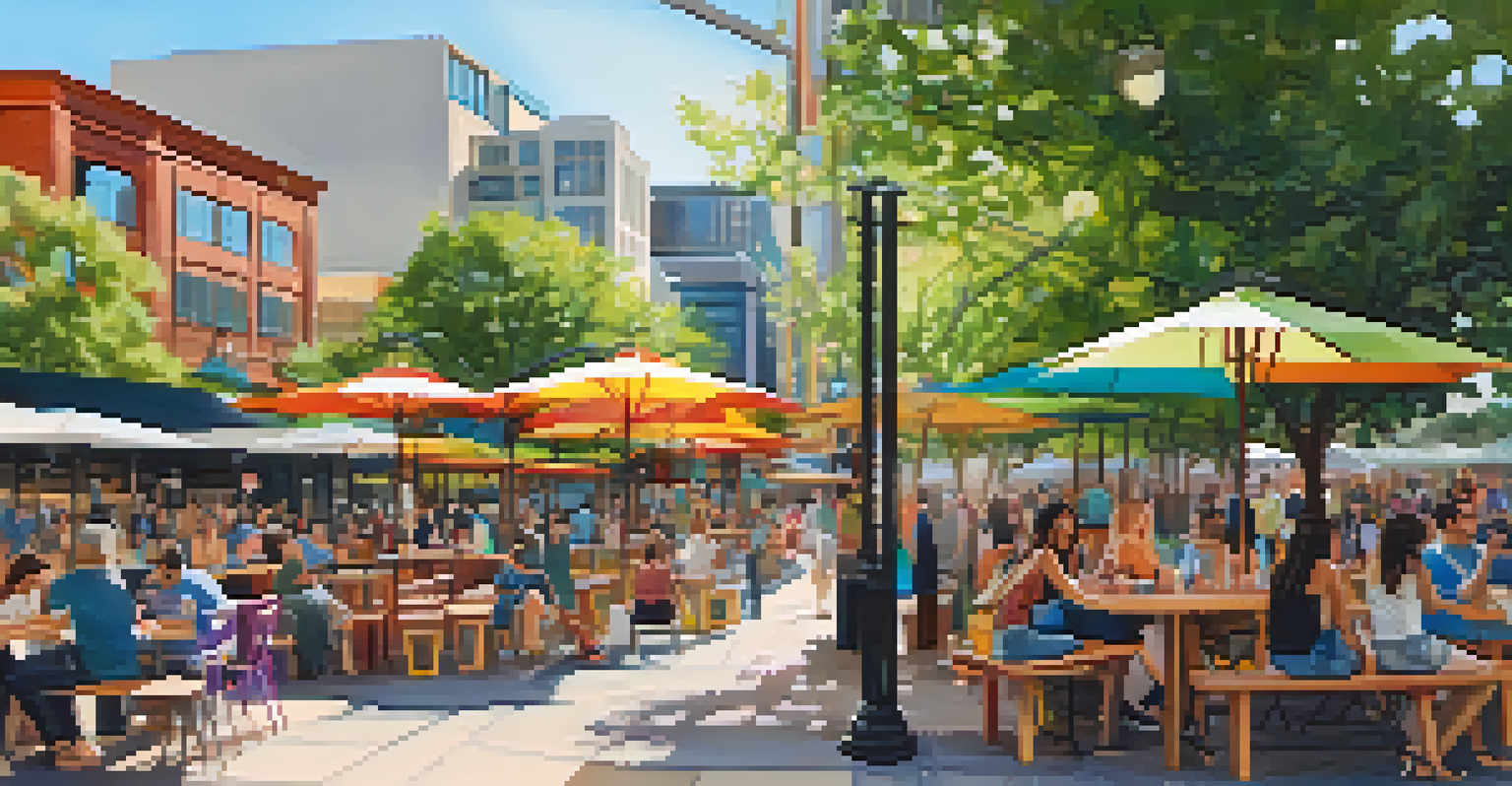Austin's Commitment to Sustainable Transportation Initiatives

Austin's Vision for a Greener Future
Austin has set a remarkable vision for a sustainable future, focusing on transportation as a key component. With a growing population and increasing traffic, the city recognizes the urgent need for eco-friendly solutions. This vision not only aims to reduce carbon emissions but also to improve the overall quality of life for its residents.
Sustainability is not a destination, but a journey we embark on together.
By prioritizing sustainable transportation, Austin is positioning itself as a leader in environmental stewardship. The initiatives reflect a deep commitment to reducing reliance on fossil fuels and promoting cleaner alternatives. This approach resonates with the community's values, emphasizing the importance of environmental responsibility.
As the city embarks on this journey, it seeks to engage residents through public forums and initiatives. The collaboration between local government, businesses, and citizens is crucial for the success of these sustainable transportation efforts. Together, they aim to create an inclusive environment that encourages green practices.
Expanding Public Transportation Options
A cornerstone of Austin's sustainable transportation plan is the expansion of public transit options. The city is investing in modernizing its bus and rail systems to make them more efficient and accessible. This includes introducing electric buses and expanding routes to underserved areas, ensuring everyone has access to reliable transportation.

By enhancing public transportation, Austin hopes to entice more residents to leave their cars at home. This shift not only decreases traffic congestion but also significantly reduces greenhouse gas emissions. The goal is to create a seamless and enjoyable transit experience that encourages long-term changes in commuting habits.
Sustainable Transport Initiatives
Austin is prioritizing eco-friendly transportation solutions to reduce emissions and enhance residents' quality of life.
Moreover, Austin’s public transit improvements are designed with sustainability in mind. The integration of technology, such as real-time tracking and mobile ticketing, makes the system user-friendly and efficient. As a result, more people may consider public transportation as a viable option for their daily commutes.
Investing in Bicycle Infrastructure
Austin's commitment to sustainable transportation also includes a strong focus on cycling. The city has been actively investing in bike lanes and trails to create a safer environment for cyclists. This initiative not only promotes physical health but also encourages a shift away from vehicle use for short trips.
The greatest threat to our planet is the belief that someone else will save it.
By expanding the cycling network, Austin aims to connect neighborhoods and essential services, making it easier for residents to choose biking as a mode of transportation. The city has also launched bike-sharing programs, providing convenient options for those who may not own a bike. This accessibility plays a crucial role in fostering a cycling culture.
As more residents embrace biking, the positive effects ripple through the community. Reduced traffic congestion, improved air quality, and healthier lifestyles are just a few benefits that arise from increased cycling. Austin's biking initiatives exemplify how cities can promote sustainability while enhancing urban living.
Promoting Pedestrian-Friendly Spaces
In addition to biking, Austin is committed to creating pedestrian-friendly spaces throughout the city. This initiative focuses on enhancing sidewalks, crosswalks, and public plazas to encourage walking as a primary mode of transportation. With well-designed pathways, residents feel safer and more inclined to stroll around their neighborhoods.
The benefits of walkable environments extend beyond convenience; they contribute to healthier lifestyles and stronger community bonds. By fostering areas where walking is enjoyable, Austin is encouraging residents to engage in outdoor activities. This not only promotes physical health but also strengthens social interactions among community members.
Investing in Diverse Transit Options
The city is expanding public transit, biking infrastructure, and pedestrian-friendly spaces to promote sustainable commuting.
Moreover, pedestrian-friendly initiatives contribute to reducing reliance on cars, leading to less traffic and lower emissions. The city is also exploring the integration of green spaces within urban areas, making walking not just a necessity but also a pleasure. This holistic approach to urban design reflects Austin's commitment to sustainability.
Innovative Electric Vehicle Initiatives
Austin is also taking significant strides in promoting electric vehicles (EVs) as part of its sustainable transportation initiatives. The city has implemented programs to encourage EV adoption, including incentives for residents to buy electric cars. This effort aligns with the broader goal of reducing greenhouse gas emissions and reliance on fossil fuels.
Charging infrastructure is a crucial element of this initiative, and Austin is expanding its network of public charging stations. By making it convenient for EV owners to charge their vehicles, the city aims to alleviate concerns about range anxiety. This increased accessibility will likely boost the number of electric vehicles on the road.
Furthermore, Austin is collaborating with local businesses and organizations to promote electric vehicle use. Educational campaigns highlight the benefits of EVs, not just for the environment but also for long-term cost savings. As more residents transition to electric vehicles, Austin takes another significant step toward a sustainable transportation future.
Community Engagement and Education
A key factor in the success of Austin's sustainable transportation initiatives is community engagement. The city actively seeks input from residents through surveys, public meetings, and outreach programs. This involvement ensures that the initiatives align with the needs and preferences of the community, fostering a sense of ownership.
Education plays a vital role in promoting sustainable transportation practices. Austin has launched campaigns to raise awareness about the benefits of walking, biking, and using public transportation. By informing residents about the positive impacts of these choices, the city encourages them to adopt more sustainable habits.
Community Engagement is Key
Active involvement and education of residents are crucial for the success of Austin's sustainable transportation efforts.
Through workshops and events, Austin is also showcasing the various transportation options available to residents. The emphasis on community involvement and education creates a supportive environment for sustainable practices. As residents become more informed, they are more likely to participate in these initiatives, driving positive change.
Measuring Success and Future Goals
As Austin moves forward with its sustainable transportation initiatives, measuring success is crucial. The city has established benchmarks to evaluate the effectiveness of its programs and track progress over time. This data-driven approach allows for adjustments and improvements, ensuring that the initiatives remain relevant and impactful.
Future goals include expanding the reach of public transportation, increasing the number of bike lanes, and enhancing pedestrian infrastructure. Austin aims to create a seamless network that supports various modes of transportation, making it easier for residents to choose sustainable options. This comprehensive approach reflects the city's commitment to long-term sustainability.

Additionally, the city is exploring innovative solutions such as smart transportation technologies and partnerships with private companies. These collaborations can enhance the overall transportation experience and contribute to achieving sustainability goals. Austin's focus on continuous improvement positions it as a model for other cities striving for sustainable transportation.